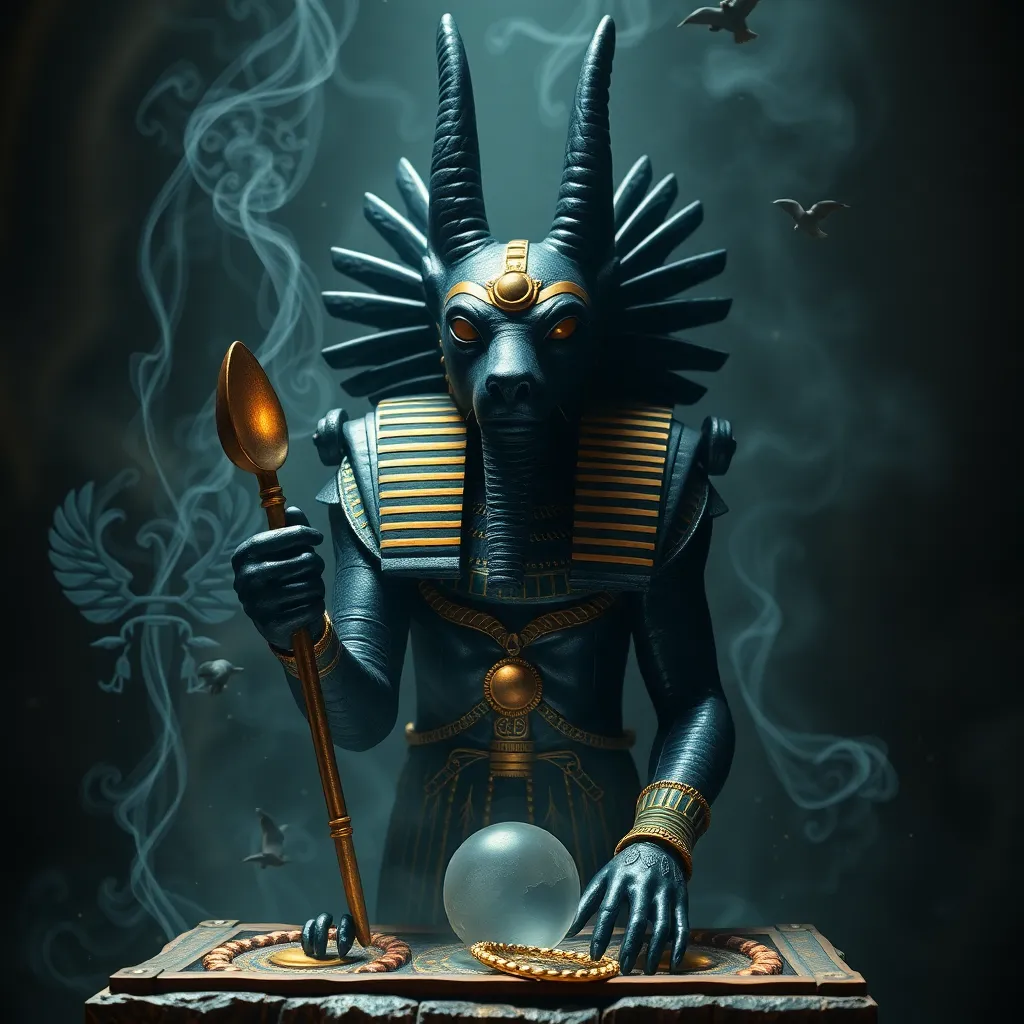The Embalmer’s God: Anubis and the Ancient Egyptian Funeral Ritual
I. Introduction
Anubis, the ancient Egyptian god often depicted with the head of a jackal, holds immense significance in the pantheon of Egyptian deities. Revered as the god of embalming and the afterlife, Anubis played a crucial role in the intricate and elaborately structured funeral practices of ancient Egypt. These rituals not only honored the deceased but also reflected the Egyptians’ profound beliefs about the afterlife and immortality. This article aims to explore Anubis’ pivotal role in these funeral rituals, the processes involved in mummification, and the cultural legacy that continues to influence modern perspectives on death and the afterlife.
II. The Role of Anubis in Ancient Egyptian Mythology
Anubis is often regarded as the god of embalming, guiding souls through the transition from life to the afterlife. His prominence in mythology is underscored by several key aspects:
- Anubis as the god of embalming and the afterlife: Anubis was believed to oversee the mummification process and protect the dead. He ensured that the deceased were properly prepared for their journey into the afterlife.
- Symbolism of Anubis in art and literature: Anubis is frequently depicted in tomb paintings and carvings, symbolizing protection and guidance. His imagery often appears alongside funerary texts, reinforcing his role in assisting souls.
- Anubis’ lineage and relation to other deities: Anubis is often associated with Osiris, the god of the afterlife, and Isis, his mother. This connection emphasizes the familial ties among the gods that govern the afterlife.
III. The Importance of Mummification in Ancient Egyptian Beliefs
Mummification was a sacred practice rooted in the Egyptians’ beliefs about the afterlife. The significance of this process is multifaceted:
- The process of mummification and its significance: Mummification involved the preservation of the body, which was essential for the deceased’s survival in the afterlife. Egyptians believed that the soul required a physical form to inhabit.
- Beliefs about the afterlife and immortality: The ancient Egyptians held a firm belief in an afterlife where the soul would journey through various challenges before reaching a paradise known as the Field of Reeds. This belief motivated the elaborate practices surrounding death.
- How mummification reflects social status and wealth: The complexity of mummification processes varied greatly depending on an individual’s social status. The wealthier the individual, the more elaborate the mummification and burial rituals, which included ornate coffins and elaborate tombs.
IV. The Embalming Process: Rituals and Practices
The embalming process was a sacred ritual carried out by skilled embalmers, who were often considered priests of Anubis. This process involved several key stages:
- Overview of the embalming process: The body was first washed and purified, followed by the removal of internal organs, which were then preserved separately. The body was desiccated using natron, a natural salt.
- Key rituals performed by embalmers: Rituals included prayers and offerings to Anubis, as well as the recitation of specific spells to ensure the safe passage of the deceased’s soul.
- Materials and tools used in mummification: Embalmers used a variety of tools, including knives, jars for organs, and various substances like resin and oils to preserve the body and its features.
V. Anubis’ Iconography and Representation
Anubis is one of the most recognizable figures in ancient Egyptian art, characterized by distinct physical attributes:
- Physical attributes of Anubis: Typically depicted as a man with the head of a jackal, Anubis embodies both human and animal traits that symbolize his role as a guide.
- Artistic depictions of Anubis in tombs and temples: Anubis is often found in various artworks, including sculptures and reliefs in tombs, emphasizing his protective role over the deceased.
- The evolution of Anubis’ representation over time: Over the centuries, Anubis’ depiction evolved, reflecting changes in religious beliefs and artistic styles within ancient Egypt.
VI. Anubis in Funerary Texts and Spells
Anubis also plays a critical role in ancient Egyptian funerary literature, particularly in guiding souls through the afterlife:
- Role of Anubis in the “Book of the Dead”: Anubis is frequently mentioned in this collection of spells and prayers, serving as a protector and guide for the deceased.
- Spells and prayers invoking Anubis during funerals: Various spells were recited to invoke Anubis’ protection, ensuring the deceased’s soul was not lost during its journey.
- The significance of these texts in guiding souls to the afterlife: The “Book of the Dead” served as a crucial guide for the deceased, providing instructions and spells to navigate the challenges of the afterlife.
VII. The Cultural Legacy of Anubis and Egyptian Funeral Practices
The influence of Anubis extends beyond ancient Egypt, affecting various cultures and religions over time:
- Influence of Anubis on later cultures and religions: Anubis’ themes of death and the afterlife have been mirrored in various cultural practices around the world.
- Modern interpretations of ancient Egyptian burial customs: Contemporary fascination with ancient Egyptian culture has led to a resurgence of interest in mummification and burial practices.
- Preservation of Anubis’ legacy in contemporary society: Anubis remains a popular figure in modern media, art, and literature, symbolizing the mysteries of death and the afterlife.
VIII. Conclusion
In conclusion, Anubis played a vital role in ancient Egyptian funeral rituals, serving as the protector and guide of the deceased. His significance is woven into the fabric of Egyptian beliefs about death and the afterlife, reflecting the culture’s profound respect for the journey beyond this life. The rituals surrounding mummification not only reveal the Egyptians’ views on immortality but also illustrate the social hierarchies of their society. As we reflect on Anubis and these ancient practices, we recognize their enduring impact on modern beliefs about death, highlighting the timeless nature of our fascination with the afterlife. Ultimately, Anubis stands as a cultural icon, reminding us of the deep-seated human desire to understand and honor the mysteries of death.




